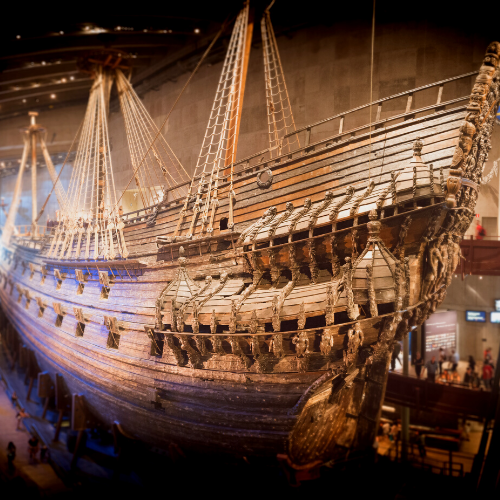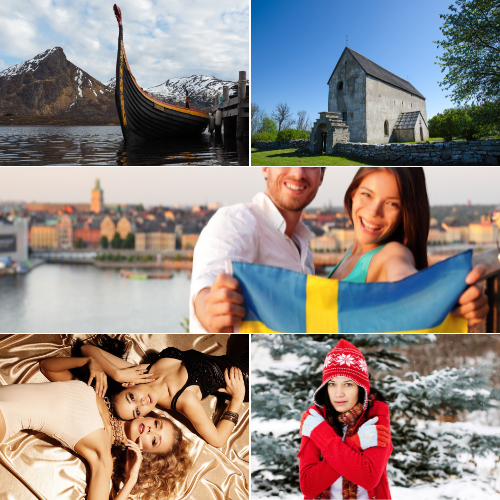The red Cottage
Red cottages with white corners and other white trimmings are as iconic as Fika in Sweden. Many houses in Sweden are made of wood and need to be painted, the question is why so many are painted in the color Falu Rödfärg – Falu red? But to tell the story about these red cottages that you can see everywhere in Sweden we must go back in time to a place called Falun, in Dalarna, in the middle of Sweden.
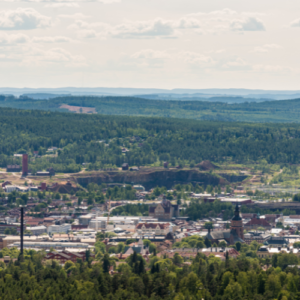
Falun
A tiny dot on the map of Sweden, 223 km (138.5 miles) northwest of Stockholm, not too far from the border with Norway, Falun is the capital of the ancient medieval Swedish kingdom of Dalarna, referred to as the ‘Swedish dales’ thanks to its scenic hills, valleys, and beautiful lakes.
The town developed around an old copper mine (dating from the late 13th century) and became the headquarters of the Stora Kopparberg Mining Company, probably the oldest industrial corporation in the world, chartered in 1347.
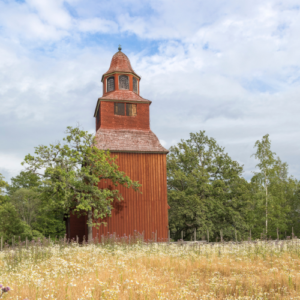
The origin of Falu Red
Legend has it that, in the 8th century, the white goat Kåre, with its red-stained fur, set the local farmers on the track of the copper sources. At this time people started to collect and melt bog ore. Later they built galleries and lit underground fires to separate the ore from the rock. By 1288, according to records from the time, Kopparberget was a profitable industrial site with its own mining company.
Nearby, the town of Falun was built, which for a time was the second largest town in Sweden after Stockholm. Many of the wooden houses are built on blocks of copper slag and painted with “Falun rödfärg”, a color that was extracted from the red oxide of the mine. Kopparberget’s continued development and prosperity had a significant influence on Sweden’s advancement as a great European power. The collapse of the mine in 1687 brought to an end Kopparberget´s time of prosperity. Nevertheless, the mine remained active until 1992 and produced other precious metals such as gold and silver. Today, the many manor houses, smelting works, and miners’ villages are evidence of the great importance that the local copper industry once had for Sweden and Europe.
Falu Gruva was once the largest copper mine of its time. The site and the most visited tourist attraction in the municipality of Falu Kommun and in the whole of Dalarna. A small part of the mine was opened to the public as early as 1970. A lift has taken visitors to a shaft 67 meters (220 ft.) below ground ever since. On December 8, 1992, ore mining in the mine finally ceased.
The Falun Mine has been operating since the 7th century and Falu Rödfärg has had industrial production here since 1764 – more than 250 consecutive years without interruption – which is absolutely unique!
The mine, which dates back over 1,000 years, in the 17th century, accounted for 70% of the western world’s copper production. As the major producer of copper, Sweden exerted a strong influence on the technological, economic, social, and political development of Europe.
Falun Mine had a large influence on mining technology across the globe. Many of Europe’s greatest buildings, including the Palace of Versailles, were roofed with Falun copper. The mine also helped Sweden become an economic powerhouse in the region.
At its peak, 1,000 Swedish workers worked below the surface in the mines. At the end of the day, they would light fires which would burn overnight and help the ore break loose in the morning. It meant the deep tunnels were usually hot and dirty, creating a challenging environment for workers. They would move forward about one meter each month.
The Falun Mine is one of Sweden’s most important industrial monuments.
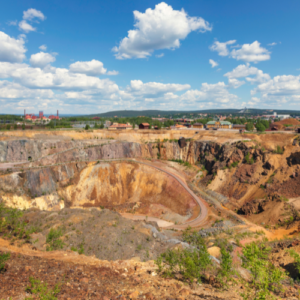
Greatest cave-in in the mine’s history
So let’s talk about that great collapse that I mentioned earlier. The huge collapse in 1687 is one of the best-known occurrences in the history of Falun Mine. Before midsummer, there had already been worrying sounds heard from underground. Then it struck: on Midsummer’s Day the greatest cave-in ever occurred. Above ground, there were three open pits and their dividing “walls” collapsed. As far down as 300 meters (984 ft) below ground, rubble from the cave-in was found. Stora Stöten – the Great Pit – had been formed, a mile in circumference (1.6 km.) and 95 meters (312 ft) deep. The occurrence became known throughout Sweden and on the Continent for the fact that no single mineworker had lost his life – all of them were off work for the traditional Swedish Midsummer holiday.
Today, one of the best viewpoints of the site is Hyttberget, a slag hill, which itself is part of the area’s industrial heritage. From Hyttberget you can see the dramatic red gorge of the collapsed mine and the small village of Falun surrounded by woodlands and lakes.
So why are all so many houses painted red
Actually, the history of our beloved Swedish red color begins in the 14th century, newly built or previously whitewashed stone churches were plastered with red lime paint to make them look like brick. They wanted them to resemble the magnificent Gothic cathedrals.
The deception continued when Johan III ordered that the roofs of Stockholm’s castle be dyed red with the help of “mine bran” from Kopparberget in Falun. The king had whitewashed Tre Kronor Castle to make it look like a Renaissance palace, and now he wanted to make the roofs look like they were made of copper. But copper was expensive. even for a king. It was cheaper to color the roofs with red pigment mixed with linseed oil, cod liver oil, or tar.
Red tar soon became a common way of treating the mountain panel on church roofs and bell towers.

Then came the 17th century, with feverish construction activity. The upstarts of the great power era couldn’t get enough of mansions and castles, and of course, they had to have a stately appearance. Ideally, they would look like the newly built knight’s house in Stockholm. But the new nobility rarely had that much money. They had to make do with wood but provided the knot-timbered mansions with red-colored facades.
Since the king was painting his house with red paint, it wasn’t long before the noblemen also wanted to paint their houses with red paint. Painting one’s house in the 17th century was very exclusive and uncommon and only possible for the wealthiest people. The pigment was mixed with wood tar for both protection and color. Once the nobility painted their houses red, of course, the priests and officers also wanted to have red houses. Red log houses were signs of wealth and status. Red brick buildings on the continent were the role model.
In the 18th century, it moved on from the officers’ and priests’ estates to prosperous miners’ estates and farming estates. At the same time, it became more common for the buildings in the cities to be covered with panels and painted. The city authorities ordered street façades to be painted red before royal visits. Painting the buildings was expensive and usually, only the façades facing the streets, only what could be seen, were painted and the back sides were still left unpainted.
In the 19th century, the farmers began to paint their homes and outbuildings. Of course, the soldiers and crofters also wanted red houses. National romanticism swept over the country and the paint was now beginning to reach the common man. Now, the ball was really rolling and at the beginning of the 20th century, the big “own-your-own-home movement” and the local heritage movement get underway and all Swedes were to have the possibility to own their own homes. There, many of the houses were painted a beautiful red. Today, the paint is still used on a large scale and used for everything from modern, architect-designed villas to public buildings, cowsheds, summer cottages, and fences.
It’s absolutely unique that a product has remained modern through the ages and many, many generations. A product and a paint that has colored an entire country and given it a distinctive national character and international identity.

So What about the color
Since 1764, Falu Rödfärg has been produced in the area around Falu Mine, basically in the same way and with the same recipe as now. Today, it is as natural a choice for architect-designed villas and public buildings as it is for summer cottages and boathouses.
All kinds of buildings: the woodshed, the manor, and the castle, have been painted red throughout cultural history in Sweden. Today, the color is used as much by modern architects as by the do-it-yourselfer on the summer cottage. No other color has been relevant in Sweden for 500 years.
Going back centuries in time, Falu Rödfärg has been synonymous with the Swedish ideal. In the 16th century, castles and manors were painted red to resemble Europe’s stately brick buildings. In the 17th century, this red color became a status symbol in the cities, and the 18th century saw this style spread to the manor houses, workmen’s houses, and rectories.
The 19th century saw Falu Rödfärg become popular among country cottages and barns, and in the 20th century private residences also started to use the color. Today, a new generation of architects has rediscovered Sweden’s national color. Falu Rödfärg shall always and forever be modern, progressive, and even challenging.
How the pigment is made

The pigment used in Falu Rödfärg comes from ore mining in the Falun Mine. The ore from the mine is hand-sorted, and stones with too low a copper content are put to the side in what is known as waste heaps. Iron oxide, which gives the pigment its red color, is caused by the presence of iron, pyrite, pyrrhotite, and chalcopyrite in the ore. When iron-bearing minerals decompose, limonite is formed which is yellow or yellowish brown in color.
The pigment production is divided into a slurrying stage and a burning stage. In the slurrying stage, the raw material is mixed with water so that the fine, decomposed material can be washed away from the stones. The fine-grained material is then pumped into a settling basin, where it can sink to the bottom over a few months. After this, the clarified water can be pumped away so that only the sediment remains. In order to transform the limonite in the sediment, it must be dried and burned. In the drying kiln, all the water disappears at approximately 150 degrees (302 F) and the sediment changes color and begins to go from yellow to red. The material is fed from the drying kiln into the firing kiln where the pigment’s final color will be determined. This is because its color changes when the temperature is increased. At a temperature of 500 degrees 932 F), the limonite transforms into iron oxide and becomes light red, at 700 degrees (1292 F) the color turns to a darker shade, and above 950 degrees (1742 F) a black shade can be expected.
Tests are performed every hour to ensure the right pigment shade is reached. After 5-7 hours in the kiln, the unground pigment is moved into silos from which it is finally fed for grinding and storage. As for the all-important Falu red, that helps protect the wood from fungal infestation and harsh weather conditions. On top of that, the pigment from the red color absorbs a large number of UV rays, so the paint lasts for longer.
Falu Rödfärg Original is Sweden’s most well-tried house paint, but it has one limitation. It can only be painted on unpainted or distemper-painted wood.
The name Falu Rödfärg is legally protected and may only be used for paint containing pigment from the Falun Mine.
Falu Rödfärg is not just a house paint, it is Swedish cultural history in a tin.
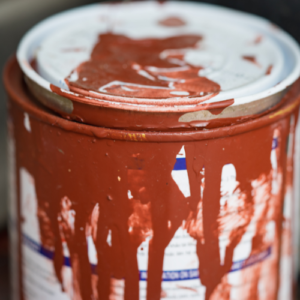
Falu Red Today
NCS S5040-Y80R may sound like a Nasa space shuttle, but it’s actually something very earthly – the Swedish color code for Falu red, the shade you see on thousands of buildings across the country. This particular shade of red is iconic. Shades of Falu red now coat a variety of Swedish structures ranging from small homes and barns to large-scale university and apartment buildings. Today the Falu red can be seen on everything from old mansions to outbuildings and modern villas in Sweden. There are red-painted heritage buildings and the odd new office blocks. Today the tradition lives on, but the pigment has often been replaced by color.
Of course, the red pigment will always be available in some way or another; the right shade of red can be produced with any source of iron oxide and already lots of synthetic and almost identical variations are on the market. Still, some people swear on the official Falun mine-sourced paint. Falu Rödfärg is the largest producer of red paint in Sweden, selling approximately 2 million liters (439938 Gallons) of paint a year. It’s debatable whether or not pigment sourced from the mine makes a true difference, but it is indisputable that the color red will continue to be synonymous with the Swedish countryside— a place often associated with coziness and childhood nostalgia.
Upcoming
Yesterday, September 12th, 2022, was election day in Sweden, and you can’t really make a podcast about Sweden and Swedes without talking about the election, so in my next episode I will do my best to explain the electoral system, and hopefully, we will have a final count done and I can share the result with you.
Until next time
As we say in Sweden
Hej Då!

